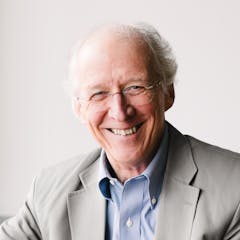Audio Transcript
Welcome back. This new week on the podcast starts off by wrapping up a bundle of recent apologetics questions on the person and work of Christ. We recently looked at six reasons why Jesus had to leave Earth after Easter. Imagine life on earth if Christ were still here with us! He’s not; why not? That was APJ 1978. Then we looked at the question, Why didn’t Jesus have to pay eternally for our sins? Isn’t that the cost — eternal judgment? So, why was his suffering cut so short? That was APJ 1979. And then we looked at the question, Even if the Christian faith is untrue — if the cross and resurrection didn’t happen — aren’t Christians still happier than non-Christians in this life? Don’t our present life priorities make for a more fulfilling experience of this life than the non-Christian’s experience, seeking joy in the world — even if we are wrong? That was APJ 1977.
Related to that one comes today’s question: Why don’t we have more artifacts, more archaeology, or even a more diversified record of historical documents to corroborate the death and resurrection of Christ? Shouldn’t we have more? The question is from a listener named Terri. “Pastor John, hello to you. My question for you is why, in this age, it remains so easy for non-believers to refute the crucifixion and resurrection of Jesus. If God controls everything, why is the existence of Jesus, and his crucifixion, not made more undeniable? People can so easily say that the events of the Bible are not real. Why did God not orchestrate it so that there were more witnesses, more archaeological evidence, more handwritten accounts? Why did he seem to leave so much room for doubt?” Pastor John, how would you respond to Terri?
I have two main responses to this question. The first is that, historically speaking, the text of the New Testament — the Greek text of the New Testament, the written accounts of first-century witnesses to Christ — is spectacularly reliable. That’s number one. I’ll come back to it and explain why in a minute.
Second, the obstacles that hinder warranted belief — justifiable belief in the truth of those first-century testimonies — are the same obstacles that people experienced who were looking Jesus right in the face and did not believe, in spite of all his signs. In other words, the root problem, today and then, is not and was not the absence of evidence.
Spectacularly Reliable
Now, why do I say that the New Testament accounts of the first-century Christian witnesses are spectacularly reliable? Terri asks, “Why did God not provide more handwritten accounts?” Now, I wonder if people who ask that have any idea what they are saying. Caesar’s Gallic Wars was written about 50 BC, and there are ten surviving manuscripts. Livy’s History of Rome has twenty surviving manuscripts. Tacitus’s Histories and Annals — written about AD 100 — has two manuscripts. Thucydides’s History — which was written about 400 BC — has eight manuscripts. And most scholars of such sources go about their work with confidence that they are in touch with the original witnesses.
Now, according to the Institute of New Testament Textual Research in Münster, Germany, there are 5,800 manuscripts or fragments of manuscripts of the New Testament. Not two, not ten, not twenty, not eight. It is a spectacular wealth of handwritten accounts of what was originally written, and hundreds of them are older than anything we have for those secular histories.
The science of textual criticism that handles these thousands of manuscripts is able to compare those manuscripts and determine with astonishing accuracy what the original manuscripts actually said. Here’s F.F. Bruce — he was from the previous generation; he was alive when I was studying as a seminary student. He wrote this:
If the great number of manuscripts increases the number of scribal errors [copying errors as you go from one copy to the next], it increases proportionately the means of correcting such errors so that the margin of doubt left in the process of recovering the exact original wording is, in truth, remarkably small. (14)
Now, that comes from The New Testament Documents: Are They Reliable? which you can still get at Amazon. I recommend it. I also recommend Paul Wegner’s A Student’s Guide to Textual Criticism of the Bible, and Craig Blomberg’s The Historical Reliability of the Gospels.
Crucified in History
The remarkable fact is that most historical scholars today — liberal or conservative — believe that the Greek texts that we have in the New Testament are really what the authors wrote near the time when the events actually happened.
“The problem of unbelief is not mainly a lack of evidence, but a deep heart resistance to God and his will.”
Which also means, for example, that when your Muslim friends tell you that the New Testament we have is not the New Testament that was originally written, but a much later creation of the church, you need to know there is zero — I’m talking zero — historical evidence for that claim. They are not making a historically justifiable statement. It is demanded by their faith — not by historical evidence — because they don’t want anyone to think Jesus was actually crucified.
But in fact, the crucifixion of Jesus is one of the most historically certain events of the first century. The view that it didn’t happen is highly eccentric from a historical standpoint.
Root Obstacle to Belief
Let me turn now to my second response, which I think is probably existentially the most significant part of Terri’s question. The obstacles that hinder justified belief in the truth of these testimonies today are the same set of obstacles that people experienced who were looking at Jesus in his own day — right in the face, flesh to flesh, eye to eye — and did not believe. In other words, the root problem is not the absence of evidence.
You remember the story of the rich man and Lazarus in Luke 16:19–31 — the rich man and the poor man. Lazarus died. Lazarus went to heaven in Abraham’s bosom, and the rich man went to torment. In the torment, he says across this chasm to Abraham,
“I beg you, father, to send [Lazarus] to my father’s house — for I have five brothers — so that he may warn them, lest they also come into this place of torment.” But Abraham said, “They have Moses and the Prophets; let them hear them.” And he said, “No, father Abraham, but if someone goes to them from the dead [in other words, if there’s enough evidence; if there’s a sign], they will repent.” [Abraham] said to him, “If they do not hear Moses and the Prophets, neither will they be convinced if someone should rise from the dead.” (Luke 16:27–31)
Now, that’s amazing. What it means is that the same inner condition of heart that keeps a person from believing the Old Testament prophets also keeps him from submitting to the evidence of actually seeing someone rise from the dead. That was true then, and it’s true today.
Against the Evidence
You remember the other Lazarus (remember there are two Lazaruses in the New Testament). Jesus raised this Lazarus from the dead. He was dead for four days, and Jesus raised him from the dead to give a sign that people would believe and glorify God. When that miracle happened, some believed — in fact, it says “many . . . believed” in John 11:45. But others went and told the Pharisees. Their response was that they plotted to kill Jesus, and they plotted to kill Lazarus to get rid of the evidence (John 11:57; 12:10).
More than once, people demanded a sign from Jesus even after he had done so many compelling signs already. And here’s what Jesus said to them in John 10:24–27:
The Jews gathered around him and said, “How long will you keep us in suspense? If you are the Christ, tell us plainly.” Jesus answered them, “I told you, and you do not believe. The works that I do in my Father’s name bear witness about me, but you do not believe because you are not among my sheep. My sheep hear my voice, and I know them, and they follow me.”
Here’s what Jesus said to explain that — how a person could come to see Jesus as true. He said in John 7:17, “If anyone’s will is to do God’s will, he will know whether the teaching is from God or whether I am speaking on my own authority.”
Tell and Pray
The problem of unbelief is not mainly a lack of evidence, but a deep heart resistance to God and his will. Changing that heart condition is a great work of God. We are utterly dependent on it in our evangelism. So, let’s not be deterred in our evangelism by anyone who says there’s not enough evidence to justify belief in Jesus. There is enough evidence. No one spoke like this man. The self-authenticating glory of God shines in the gospel of Christ.
So, let’s tell the good news. Tell it everywhere. Tell it all the time. Tell it as compellingly as we possibly can. And then let’s pray. Let’s pray earnestly — all the more earnestly — that God would open the eyes of the blind.



